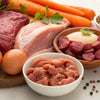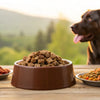Is Raw Dog Food High in Protein? Understanding the Nutritional Implications
- Houndsy
Table of Contents
- Introduction
- Understanding Protein and Its Importance for Dogs
- Raw Dog Food: A Closer Look
- Addressing Concerns: Is Too Much Protein Harmful?
- Reflective Questions to Consider
- Making the Transition: From Kibble to Raw
- Conclusion
Introduction
Have you ever wondered if switching to a raw dog food diet would provide your pup with the optimal nutrition they need to thrive? This question is at the heart of an ongoing debate among pet owners and veterinarians alike, and it's one that has gained significant attention over recent years. With the rise of raw feeding practices, many pet lovers are enraptured by the thought of offering their furry friends a more natural diet, but the true protein content found in these diets often remains shrouded in confusion.
Recent studies indicate that dietary protein is essential for dogs, influencing everything from energy levels to coat quality. However, the understanding of whether raw dog food is high in protein is layered with complexities that we need to unpack. In this blog post, we will explore the benefits and challenges of raw dog food, including how to assess protein content, the differences in moisture and dry matter, and the implications for your dog's health.
By the end of this discussion, you will have a clearer understanding of raw dog food's nutritional values and, importantly, be better equipped to make mindful choices about your dog's diet. So, let's dive in—how does raw dog food measure up in terms of protein?
Understanding Protein and Its Importance for Dogs
What is Protein?
Protein is an essential macronutrient that plays a critical role in the growth and maintenance of your dog's body. Composed of amino acids, proteins are necessary for muscle development, immune function, hormone production, and more. A well-balanced diet significantly affects your dog's health, and the type of protein they consume can make a substantial difference.
How Much Protein Do Dogs Need?
According to the Association of American Feed Control Officials (AAFCO), protein requirements can vary based on a dog's life stage. Here's a quick glance:
- Adult Dogs: Approximately 18-25% of their daily caloric intake should come from protein.
- Puppies and Pregnant/Nursing Dogs: These groups require a higher protein intake of about 22-32%.
It's important to note that, while high-protein diets are generally recommended, there is no defined maximum protein threshold for dogs. This often leads to misunderstandings about the potential impacts of increased protein levels.
The Role of Protein Quality
When evaluating dog food, it is crucial to consider not just the amount of protein but also its quality. High-quality proteins boast a better biological value, meaning they provide necessary amino acids and are more easily absorbed by your dog's body. Raw meat, organs, and bones are significant sources of high-quality protein because they closely mimic a dog's natural ancestral diet.
Reflective Question for Pet Owners
Have you ever looked closely at the protein sources in your dog's current diet? Consider the quality of the protein they are receiving and whether it aligns with their health needs.
Raw Dog Food: A Closer Look
The Appeal of Raw Feeding
Raw dog food typically consists of muscle meat, bones, organ meats, and some vegetables or fruits. Proponents argue that this approach closely replicates what dogs would naturally consume in the wild, emphasizing its perceived nutritional benefits:
- Improved Skin and Coat: Many owners report shinier coats and healthier skin when switching to raw diets.
- Better Digestion: Raw foods are said to be more easily digestible and beneficial for gut health.
- Higher Energy Levels: Owners often note that their dogs appear more vibrant and energetic.
While these benefits are promising, they must be weighed against the need for balanced nutrition.
Protein Content in Raw Diets
Some owners mistakenly assume that raw dog food is high in protein due to the presence of meat as a primary ingredient. Let's break down this assumption.
The Moisture Factor
One critical aspect in determining the protein content of any food is moisture. Raw meats often contain significant water content, which can distort the perceived protein levels when comparing them to kibble or dry foods, which have much lower moisture levels.
For example:
- Raw Chicken Breast: Contains about 20% protein on a "as-fed" basis but can show much higher percentages when analyzed on a dry matter basis—around 40-60%—when moisture is removed.
- Kibble: Typically has around 25-30% protein, but remember, this number reflects a much drier food source.
The difference in moisture content can mislead pet owners trying to assess whether raw diets meet their dog's protein needs.
Dry Matter Basis: Understanding the Real Numbers
To make effective comparisons, one can convert the nutritional analysis of raw foods to a dry matter basis. The following formula can be used:
- Subtract moisture percentage from 100.
- Divide the percentage of protein by the number you got in Step 1.
- Multiply the result by 100.
This allows an accurate comparison with kibble or other dry food options. For instance:
- If raw chicken is 80% moisture, protein calculation would show it is far less advantageous in terms of pure protein per food weight compared to a kibble.
Key Takeaways on Raw Dog Food Protein
While raw meat may appear to be high in protein, moisture significantly alters that metric. Thus, the real question to ask is—Does your dog require that level of protein? Each dog's needs vary based on their unique health and lifestyle.
Addressing Concerns: Is Too Much Protein Harmful?
The Myth of High Protein and Kidney Health
For years, there have been concerns that high protein diets may lead to kidney issues in dogs. However, evidence supporting this claim remains controversial.
- Many studies suggesting a link between high protein intake and kidney problems were conducted on rodents, which have vastly different digestive systems than dogs.
- Canines are carnivorous by nature and possess enzymes that effectively process proteins. As a result, increased protein levels do not generally pose health risks for healthy dogs.
Understanding Individual Needs
While some dogs may suffer from conditions like kidney disease that do require lower protein diets, most healthy dogs thrive on higher protein foods. It's critical for pet owners to recognize their dog’s specific health conditions and consult with their veterinarian when making dietary changes.
Are There Risks Involved with Feeding Raw?
While raw diets can offer high-quality proteins, potential risks also exist:
-
Bacterial Contamination: Raw meats can carry pathogens like Salmonella or E. coli, posing risks not only to the dog but also to human family members.
-
Nutritional Imbalances: Homemade raw diets can lack certain nutrients if not properly balanced. It's wise to consult with a vet or a pet nutritionist when switching to homemade raw foods.
-
Bone Hazards: Whole bones can pose choking hazards or cause internal injuries. Careful selection and preparation of bones are necessary.
Conclusion on Raw Dog Food Risks
Feeding raw dog food can provide amazing nutritional benefits and boost energy levels, but pet owners should remain vigilant in considering potential health risks while ensuring their dog's diet remains well-rounded and safe.
Reflective Questions to Consider
- Has your dog shown any allergies or sensitivities that could be addressed through dietary changes?
- Have you taken the time to research the specific protein sources in your dog's food? What quality beef, chicken, or organ meats are present?
Making the Transition: From Kibble to Raw
Transitioning Safely
Switching your dog to a raw food diet can be an exciting journey, but it must be done gradually to ensure your dog's digestive system adjusts well. Here's how you can transition smoothly:
- Start Slow: Introduce small amounts of raw food into your dog's current diet and gradually increase as they adjust. Aim for at least 10 days to two weeks.
- Monitor Reactions: Watch for any changes in digestion or demeanor. Bowel movements can indicate whether your dog is getting used to the new food.
- Balance is Key: A well-rounded raw diet should include muscle meat, organ meats, and bones. Opt for a mix of protein sources to provide a full range of nutrients.
Practical Considerations
Owning the right tools and storage for a raw food diet can help ease the transition process. For example, the Houndsy Kibble Dispenser offers an innovative solution for those who are still using traditional kibble. With its sleek design and easy portion control, it can help balance your dog's current diet until they acclimitize to the new raw feeding style. Explore the Houndsy Kibble Dispenser here.
Conclusion
In conclusion, the question “is raw dog food high in protein?” doesn't have a straightforward answer without context. Raw food diets can provide dogs with essential, high-quality protein, but moisture plays an important role in determining the actual protein concentration of these diets.
Weighing the benefits and omnipresent challenges is vital for every dog owner seeking to provide the best nutrition for their furry companions. Our commitment at Houndsy is to simplify and enhance your pet feeding experience, and we advocate informed choices to help your pet lead a healthy, joyful life.
As you consider your dog's dietary needs, think about the unique protein source you're providing and consult your veterinarian to tailor the best feeding plan for your pet. After all, every dog deserves a diet that reflects their needs and fosters their well-being.
FAQ
1. How do I know if raw dog food is right for my pet?
Deciding if raw food is suitable for your dog depends on their age, health status, and dietary requirements. Consulting your veterinarian is the best way to assess whether this type of feeding is appropriate for your pet.
2. Can I mix raw food with kibble?
While it is possible to mix raw food with kibble, it can sometimes lead to digestive upsets as they digest at different rates. It's typically recommended to feed them separately.
3. Is it safe to handle raw dog food?
Handling raw dog food requires precaution to minimize the risk of bacterial contamination. Always wash your hands after handling raw meat and disinfect surfaces to maintain hygiene.
4. What are the signs that my dog might not be handling raw food well?
Signs of digestive distress, such as diarrhea, vomiting, or decreased energy levels, can indicate that your dog is struggling with the raw diet. If these symptoms persist, consult your veterinarian.
5. How can I ensure a balanced raw diet?
A balanced raw diet includes a variety of meats—muscle, organ, and bones—and may also incorporate vegetables or fruits. Ensuring diversity in the protein sources is essential to provide complete nutrition.












